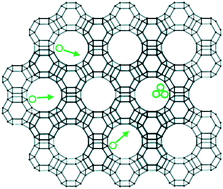Transformation of atomically dispersed platinum in SAPO-37 into platinum clusters: catalyst for ethylene hydrogenation†
Abstract
Atomically dispersed supported platinum catalysts were synthesized by the reaction of Pt(acac)2 (acac = acetylacetonato) with the silicoaluminophosphate molecular sieve SAPO-37, with infrared spectra showing that the reaction involved SAPO OH groups. Extended X-ray absorption fine structure (EXAFS) spectra show that, after heating in air to 623 K, each platinum atom on average was bonded to approximately two oxygen atoms of the SAPO support, with no evidence of platinum clusters. X-ray absorption near edge spectra (XANES) indicate a platinum formal oxidation state of approximately +2. These supported mononuclear species lacked catalytic activity for ethylene hydrogenation at 1 bar and room temperature, but activity arose during catalysis in a once-through flow reactor/X-ray absorption spectroscopy cell, as the XANES white line intensity decreased, indicating reduction of the platinum, and the EXAFS-determined Pt–Pt coordination number (CN) increased from essentially zero to 2.7 ± 0.5 after 2 h, indicating the formation of platinum clusters of only a few atoms each. The data indicate the almost instantaneous formation of the clusters and identify them as the catalytically active species. Subsequent exposure of the catalyst to ethylene as in situ EXAFS and XANES data were recorded led to a decrease in the Pt–Pt coordination number to 1.6 ± 0.3 and an increase in the white line intensity, indicating partial oxidative fragmentation of the clusters by ethylene. Platinum clusters in SAPO-37 formed in separate experiments by exposure to H2 prior to catalysis were also catalytically active for ethylene hydrogenation. The data thus show how to dial in the catalytic activity by forming platinum clusters by exposure of mononuclear platinum to H2 and how to dial back the activity by oxidative fragmentation of the clusters by reaction with ethylene, all under mild conditions; the ethylene : H2 ratio of the reactant gas determines the average platinum nuclearity and thus the catalytic activity.



 Please wait while we load your content...
Please wait while we load your content...
